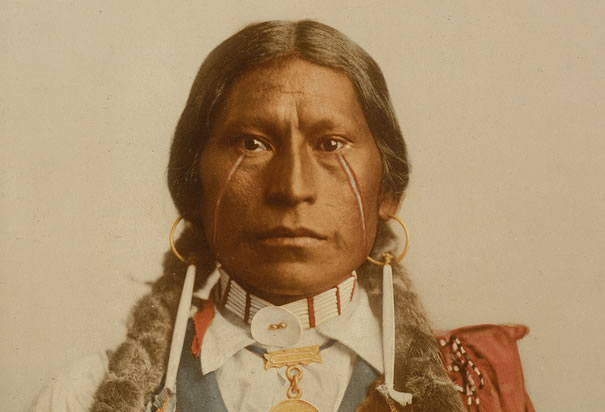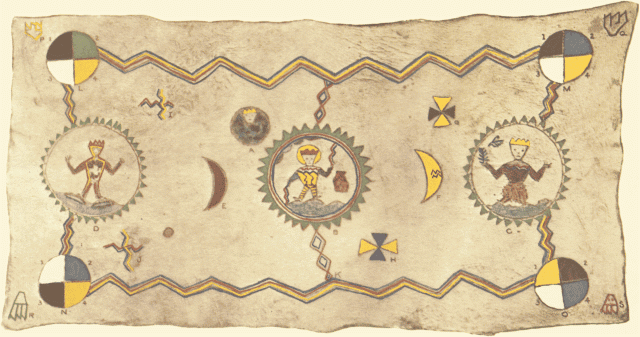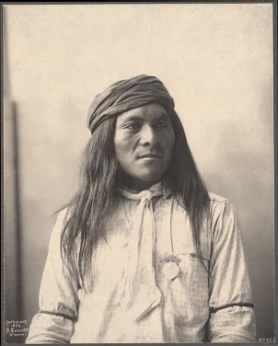About the Hopi Indian Marriage Ceremony
During the day the girl must labor at the mealing stones, grinding the white meal, silent and unnoticed;
The following is Hough's description of the wedding ceremony at Oraibi: "When the young people decide to be married, the girl informs her mother, who takes her daughter, bearing a tray of meal made from white corn, to the house of the bridegroom where she is received by his mother with thanks. During the day the girl must labor at the mealing stones, grinding the white meal, silent and unnoticed; the next day she must continue her task.... On the third day of this laborious trial she grinds the dark blue corn which the Hopi call black, no doubt, glad when the evening brings a group of friends, laden with trays of meal of their own grinding as presents, and according to the custom, these presents are returned in kind, the trays being sent back next day heavy with choice ears of corn.
"After this three days' probation ... comes the wedding. Upon that day the mother cuts the bride's front hair at the level of her chin and dresses the longer locks in two coils, which she must always wear in token that she is no longer a maiden. At the dawn of the fourth day, the relatives of both families assemble, each one bringing a small quantity of water in a vessel. The two mothers pound up roots of the yucca, used as soap, and prepare two bowls of foaming suds. The young man kneels before the bowl prepared by his future mother-in-law, and the bride before the bowl of the young man's mother, and their heads are thoroughly washed and the relatives take part by pouring handsful of suds over the bowed heads of the couple. While this ceremonial ... goes on ... a great deal of jollity ensues. When the head-washing is over, the visitors rinse the hair of the couple with the water they have brought, and return home. Then the bridal couple take each a pinch of corn meal and leaving the house go silently to the eastern side of the mesa on which the pueblo of Oraibi stands. Holding the meal to their lips, they cast the meal toward the dawn, breathing a prayer for a long and prosperous life, and return to the house, husband and wife.
"The ceremony over, the mother of the bride (Note: All other authorities say groom, H.G.L.) builds a fire under the baking stone, while the daughter prepares the batter and begins to bake a large quantity of paper bread.... The wedding breakfast follows closely on the heels of the wedding ceremony and the father of the young man must run through the pueblo with a bag of cotton, handsful of which he gives to the relatives and friends, who pick out the seeds and return the cotton to him. This cotton is for the wedding blankets and sash which are to be the trousseau of the bride....
"A few days later the crier announces the time for the spinning of the cotton for the bride's blanket. This takes place in the kivas, where usually all the weaving is done by the men, and with jollity and many a story the task is soon finished. The spun cotton is handed over to the bridegroom as a contribution from the village, to be paid for like everything else Hopi, by a sumptuous feast, which has been prepared by the women for the spinners. Perhaps ten sage-brush-fed sheep and goats, tough beyond reason, are being softened in a stew, consisting mainly of corn; stacks of paper bread have been baked, various other dishes have been concocted, and all is ready when the crier calls in the hungry multitude....
"With the spun cotton, serious work begins for the bridegroom and his male relatives, lasting several weeks. A large white blanket ... and a smaller one must be woven and a reed mat in which the blankets are to be rolled. A white sash with long fringe and a pair of mocassins, each having half a deerskin for leggings, like those worn by the women of the Rio Grande pueblos, complete the costume. The blankets must have elaborate tassels at the four corners. (Note: Representing rain falling from the white cloud blanket. H.G.L.)
"Shortly before sunrise, the bride, arrayed in her finery, performs the last act in the drama, called 'going home.' Up to this time the bride has remained in the house of her husband's people. Wearing the large white blanket, picturesquely disposed over her head, and carrying the small blanket wrapped in the reed mat in her hands, she walks to her mother's house ... and the long ceremony is over ... for in this land of women's rights the husband must live with his wife's relatives."
The bride may not appear at a public ceremonial dance until the following July, at the Kachina Farewell ceremony, when all the brides of the year turn out in their lovely wedding blankets and white leggings, the only time this blanket is ever worn after the wedding (during life), save one the naming ceremony of her first child.
It becomes her winding sheet when at death she wears it in her grave, then after four days, she takes it from her shoulders and uses it as a magic carpet when, having reached the edge of the Grand Canyon, she steps out upon her ceremonial blanket, and like a white cloud it descends with her to Maski, the underworld paradise of the Hopi.
Are the Hopi married in this way today? Most certainly. Figure 12 shows a Hopi girl who worked for the writer for three summers. She is a fine, intelligent girl, having gone more than halfway through high school before she returned to her home on Second Mesa to live. This is her wedding picture taken last year at the moment of her "going home," after just such a wedding ceremonial as described above.
Figure 12.—A Hopi Bride.—Photo by Colton.
A letter from friends of the writer states that her baby is just now going through his natal ceremonies in the good old Hopi way. If the Snake Dance is continued till he grows up—it makes one shudder to think of it—he is in line to be a Snake priest!










































































